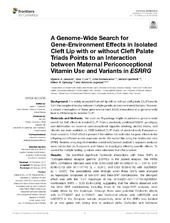| dc.contributor.author | Haaland, Øystein Ariansen | en_US |
| dc.contributor.author | Lie, Rolv T. | en_US |
| dc.contributor.author | Romanowska, Julia | en_US |
| dc.contributor.author | Gjerdevik, Miriam | en_US |
| dc.contributor.author | Gjessing, Håkon K. | en_US |
| dc.contributor.author | Jugessur, Astanand | en_US |
| dc.date.accessioned | 2019-05-10T16:31:55Z | |
| dc.date.available | 2019-05-10T16:31:55Z | |
| dc.date.issued | 2018-02-26 | |
| dc.Published | Haaland ØA, Lie RT, Romanowska J, Gjerdevik M, Gjessing HK, Jugessur A. A genome-wide search for gene-environment effects in isolated cleft lip with or without cleft palate triads points to an interaction between maternal periconceptional vitamin use and variants in ESRRG. Frontiers in Genetics. 2018;9:60 | eng |
| dc.identifier.issn | 1664-8021 | |
| dc.identifier.uri | https://hdl.handle.net/1956/19634 | |
| dc.description.abstract | Background: It is widely accepted that cleft lip with or without cleft palate (CL/P) results from the complex interplay between multiple genetic and environmental factors. However, a robust investigation of these gene-environment (GxE) interactions at a genome-wide level is still lacking for isolated CL/P. Materials and Methods: We used our R-package Haplin to perform a genome-wide search for GxE effects in isolated CL/P. From a previously published GWAS, genotypes and information on maternal periconceptional cigarette smoking, alcohol intake, and vitamin use were available on 1908 isolated CL/P triads of predominantly European or Asian ancestry. A GxE effect is present if the relative risk estimates for gene-effects in the offspring are different across exposure strata. We tested this using the relative risk ratio (RRR). Besides analyzing all ethnicities combined (“pooled analysis”), separate analyses were conducted on Europeans and Asians to investigate ethnicity-specific effects. To control for multiple testing, q-values were calculated from the p-values. Results: We identified significant GxVitamin interactions with three SNPs in “Estrogen-related receptor gamma” (ESRRG) in the pooled analysis. The RRRs (95% confidence intervals) were 0.56 (0.45–0.69) with rs1339221 (q = 0.011), 0.57 (0.46–0.70) with rs11117745 (q = 0.011), and 0.62 (0.50–0.76) with rs2099557 (q = 0.037). The associations were stronger when these SNPs were analyzed as haplotypes composed of two-SNP and three-SNP combinations. The strongest effect was with the “t-t-t” haplotype of the rs1339221-rs11117745-rs2099557 combination [RRR = 0.50 (0.40–0.64)], suggesting that the effects observed with the other SNP combinations, including those in the single-SNP analyses, were mainly driven by this haplotype. Although there were potential GxVitamin effects with rs17734557 and rs1316471 and GxAlcohol effects with rs9653456 and rs921876 in the European sample, respectively, none of the SNPs was located in or near genes with strong links to orofacial clefts. GxAlcohol and GxSmoke effects were not assessed in the Asian sample because of a lack of observations for these exposures. Discussion/Conclusion: We identified significant interactions between vitamin use and variants in ESRRG in the pooled analysis. These GxE effects are novel and warrant further investigations to elucidate their roles in orofacial clefting. If validated, they could provide prospects for exploring the impact of estrogens and vitamins on clefting, with potential translational applications. | en_US |
| dc.language.iso | eng | eng |
| dc.publisher | Frontiers Media | eng |
| dc.relation.uri | https://www.frontiersin.org/articles/10.3389/fgene.2018.00060/full | |
| dc.rights | Attribution CC BY | eng |
| dc.rights.uri | http://creativecommons.org/licenses/by/4.0/ | eng |
| dc.subject | Gene-environment interaction | eng |
| dc.subject | GWAS | eng |
| dc.subject | case-parent triad | eng |
| dc.subject | orofacial cleft | eng |
| dc.subject | cleft lip with or without cleft palate | eng |
| dc.subject | birth defects | eng |
| dc.subject | genetic epidemiology | eng |
| dc.subject | Haplin | eng |
| dc.title | A genome-wide search for gene-environment effects in isolated cleft lip with or without cleft palate triads points to an interaction between maternal periconceptional vitamin use and variants in ESRRG | en_US |
| dc.type | Peer reviewed | |
| dc.type | Journal article | |
| dc.date.updated | 2019-02-06T14:21:37Z | |
| dc.description.version | publishedVersion | en_US |
| dc.rights.holder | Copyright 2018 The Authors | |
| dc.identifier.doi | https://doi.org/10.3389/fgene.2018.00060 | |
| dc.identifier.cristin | 1592193 | |
| dc.source.journal | Frontiers in Genetics | |

